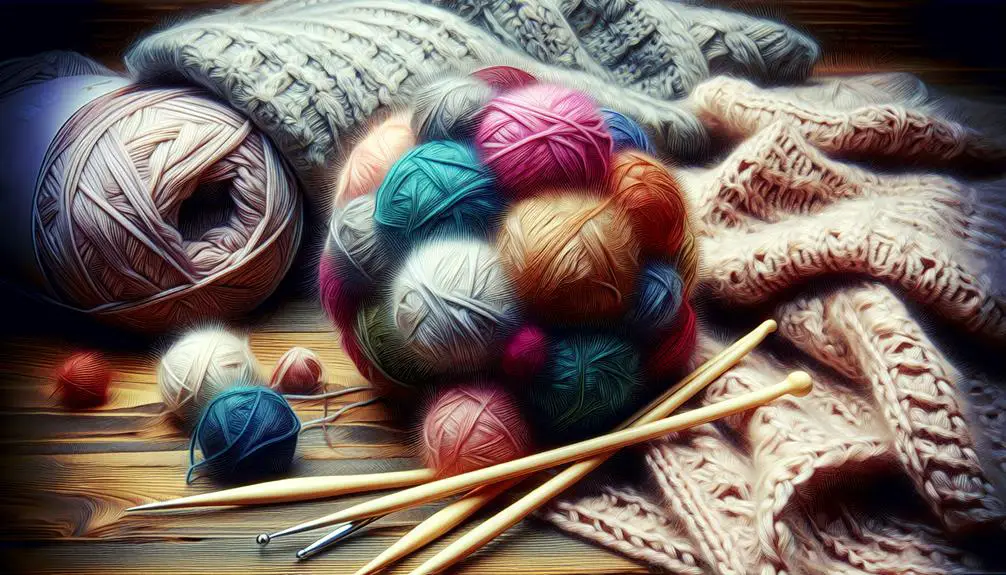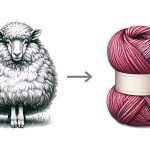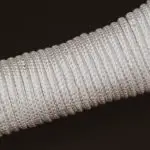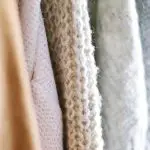When wool is spun, it's called a 'hank.' It's a single continuous strand. Want to uncover more about wool types and yarn facts?
Table of Contents
Key Takeaways
- A thing of wool is commonly referred to as a "skein."
- Skeins are twisted or wound bundles of yarn.
- Skeins are used for storage, display, and crafting.
- Yarn in skein form is easy to work with.
- Skeins help prevent tangling and keep yarn organized.
Types of Wool and Yarn
When exploring the world of knitting and crafting, understanding the various types of wool and yarn available is essential for choosing the right materials for your projects. Wool comes from different animals like sheep, goats, and alpacas, each with unique characteristics.
Merino wool, known for its fine and soft quality, is popular for garments worn close to the skin due to its comfort. Lambswool, from young sheep's first shearing, is prized for its softness and suitability for sensitive skin. Alpaca fiber, light and soft, is commonly used in blankets and coats for its versatility.
Cashmere, a luxury fiber from specific goats, provides warmth and softness in premium products. Corriedale wool, valued for its durability and warmth, is a favorite for felting, knitting, and weaving projects.
When shopping for yarn, you may encounter terms like 'skein of yarn,' which refers to a specific amount or weight of yarn for your craft projects. Understanding these types of wool can help you choose the best material for your next knitting endeavor.
Difference Between Yarn Types
I'll start by highlighting the key differences among yarn types, focusing on:
- Yarn weight categories
- Fiber content varieties
- Texture and ply
Understanding these distinctions can help crafters select the most suitable yarn for their projects based on thickness, material, and the desired finish of the final piece.
Yarn Weight Categories
Yarn weight categories categorize the thickness and density of yarn strands, ranging from lace to super bulky options. Understanding yarn weights like fingering, sport, worsted, and bulky is essential for selecting the right yarn for specific projects.
The yarn weight directly impacts the gauge, drape, texture, and appearance of the final fabric, influencing the overall outcome of knitted or crocheted items. Organizations such as the Craft Yarn Council standardize yarn weights, ensuring consistency in labeling and providing guidance on needle or hook sizes.
Fiber Content Varieties
Moving from the discussion on yarn weight categories, understanding the differences in fiber content varieties among various yarn types is essential for selecting the right material for crafting projects.
- Merino wool yarn, with its fine fibers, is soft and versatile, suitable for a variety of projects.
- Alpaca wool yarn, known for being lightweight and hypoallergenic, is perfect for cozy blankets and garments.
- Cashmere yarn, sourced from specific goats, is luxurious, soft, and warm, ideal for high-end knits.
- Corriedale wool yarn, durable and warm, is popular for felting, knitting, and weaving due to its quality and versatility.
Each of these fiber content varieties offers unique qualities that cater to different crafting needs, from softness and warmth to durability and luxury.
Texture and Ply
Exploring the texture and ply of yarn types reveals essential characteristics for selecting the right material for crafting projects. Yarn texture defines how the yarn feels and looks, offering options like smooth, textured, or fuzzy varieties. Different yarn textures such as bouclé, chenille, or tweed provide distinct qualities for knitting or crocheting projects.
On the other hand, yarn ply refers to the number of individual strands twisted together to form the yarn, with choices ranging from single to multiple plies. The ply of yarn directly influences the strength, drape, and stitch definition of the final fabric, where higher ply counts result in thicker and more durable yarn.
Understanding yarn texture and ply is vital for choosing suitable yarn types for various projects, whether creating garments, accessories, or home decor items.
Characteristics of Wool
Wool possesses remarkable natural properties that make it a top choice for various garments. It provides excellent insulation, keeping me warm during cold winters, while also being breathable and moisture-wicking, ensuring comfort throughout the day.
These characteristics highlight the versatility and practicality of wool, making it a valuable material in the domain of textiles.
Natural Fiber Properties
In the textile industry, few natural fibers possess the unique characteristics of wool.
- Wool's crimp enhances spinning and aids in heat retention.
- Its specific thermal resistance makes wool an excellent insulator.
- Wool's exceptional moisture absorption properties and sound-absorbent nature set it apart.
- Being flame-resistant, wool is preferred for firefighting gear and military uniforms.
Wool's durability, resistance to pilling, and versatility in various products like clothing, blankets, insulation, and upholstery highlight its exceptional properties. These features make wool a sought-after natural fiber for a wide range of applications in different industries due to its remarkable blend of practicality and functionality.
Insulation and Warmth
Moving from the discussion on Natural Fiber Properties, the exceptional insulation and warmth provided by wool set it apart in the textile industry.
Wool fibers have a unique crimp that traps air, creating a natural barrier against heat loss, making wool an excellent insulator. This property allows wool to keep individuals warm in cold environments, making it a popular choice for outdoor clothing and blankets.
Additionally, wool can retain moisture without feeling damp, allowing it to wick away moisture from the body while maintaining warmth. Another remarkable feature of wool is its natural flame-resistant properties, adding a safety element to products made from this material.
Breathable and Moisture-Wicking
Breathable and moisture-wicking, wool fibers offer exceptional characteristics for active wear. Here's why they stand out:
- Natural Breathability: Wool allows airflow, aiding in moisture evaporation and ensuring wearer comfort.
- Moisture-Wicking: The fabric absorbs and releases sweat, keeping the material dry and preventing that damp feeling.
- High Absorption: Wool can take in up to 30% of its weight in moisture without feeling wet, making it perfect for intense workouts.
- Temperature Regulation: The unique structure of wool fibers helps in temperature control, trapping heat when it's cold and releasing it in warmer conditions.
These properties make wool a preferred choice for outdoor activities, sports, and daily wear, providing both comfort and functionality.
Production Process of Wool
Having obtained the raw fleece through shearing, the production process of wool involves several essential stages like cleaning, sorting, and spinning to create yarn.
Wool, a textile fiber often sourced from sheep or lamb, is used to create a wide range of products. Once the fleece is sheared, it needs thorough cleaning to remove impurities like dirt, grease, and vegetable matter.
Sorting follows, where the wool is categorized based on factors like fiber length, diameter, and color. This classification is important as different grades of wool are suited for specific purposes based on their quality.
The sorted wool fibers are then spun into yarn, a process that aligns the fibers to form a durable and versatile material ready for weaving or knitting.
The production of wool is a meticulous and labor-intensive process that guarantees the high-quality fiber is transformed into various end products, from cozy sweaters to luxurious carpets, catering to diverse market demands worldwide.
Yarn Marketing Insights
After understanding the production process of wool, it's fascinating to explore the intricate world of yarn marketing insights.
Yarn Stores: Yarn stores play an essential role in showcasing and selling different types of yarn, catering to the needs of knitters, crocheters, and weavers alike.
Skeins of Yarn: Packaging yarn in skeins not only protects it but also allows for easy storage and display in yarn stores.
Hand Winding: Some yarn enthusiasts prefer hand-wound skeins for a more personalized touch, creating a unique selling point for yarn retailers.
Synthetic Fibers: The rise of synthetic fibers in the yarn industry offers a variety of options for consumers, with properties like durability and colorfastness attracting a different market segment.
Exploring these yarn marketing insights sheds light on the strategies employed by yarn producers and sellers to meet the diverse needs of consumers in a competitive market landscape.
Yarn Usage and Events
In the domain of yarn usage and events, enthusiasts showcase their creativity through a myriad of crafts and gatherings.
Yarn bowls, designed to keep yarn tidy and prevent tangling during projects, are popular among the knitting community. These bowls come in various materials and styles, adding both essential and aesthetic appeal to crafting spaces.
Knitting patterns play an important role in guiding crafters through creating garments, accessories, and decor items.
Events such as yarn festivals and workshops provide platforms for enthusiasts to explore new techniques, share ideas, and connect with fellow yarn lovers.
A hank of yarn, with its loosely wound appearance, offers a unique presentation compared to skeins or balls, often requiring crafters to wind it into a more manageable form before use.
The diverse applications of yarn, from creating intricate wearables to large-scale art installations, highlight its versatility and enduring appeal in the world of crafting.
Exploring Yarn Varieties
Exploring various yarn varieties reveals a world of texture, color, and versatility waiting to inspire crafters in their next project. When delving into the domain of yarn types, particularly those derived from animal fibers like wool, a plethora of options present themselves. Here are some fine wool varieties to contemplate:
- Merino Wool: Known for its incredibly soft and fine fibers, ranging from 10-20 microns in diameter, making it a perfect choice for luxurious and comfortable garments.
- Lambswool: This type comes from the first shearing of young sheep and is exceptionally soft, making it ideal for those with sensitive skin.
- Alpaca Wool: Versatile and lightweight, alpaca hair is commonly used in creating blankets and coats due to its softness and warmth.
- Cashmere: Sourced from specific goats in regions like India and China, cashmere is prized for its lightness, softness, and exceptional warmth, making it a premium choice for high-end projects.
Exploring these fine wool varieties can add a touch of luxury and quality to your crafting endeavors.
Understanding Yarn Weight
Let's kick off our exploration by understanding the significance of yarn weight in crafting projects.
Yarn weight refers to the thickness of the yarn strand, impacting the final look and feel of knitted or crocheted items. With categories ranging from lace (super fine) to jumbo (super bulky), each type comes with specific yardage and gauge recommendations.
Common yarn weights like fingering (sock weight), worsted (medium weight), and bulky (chunky weight) cater to different project needs. Knowing the yarn weight is essential for selecting the right yarn and ensuring proper tension and stitch definition.
It plays an important role in determining the drape, warmth, and overall appearance of the finished garment. Whether you're knitting a cozy sweater or crocheting a delicate shawl, understanding yarn weight is key to achieving the desired outcome.
Yarn Selection Tips
Consider your project type and the yarn weight carefully to select the most suitable yarn for your needs. When choosing yarn, pay attention to the fiber content to guarantee it aligns with your project requirements. Additionally, examining the yarn label for details on yardage, weight, and care instructions can help you make an informed decision. Here are some tips for selecting the right yarn:
- Yarn Cakes vs. Skeins: Decide between yarn cakes and skeins based on your project's requirements and your personal preference for working with yarn in different forms.
- Fiber Content Matters: Choose yarn with the appropriate fiber content for your project, considering factors like warmth, softness, and durability.
- Check the Yarn Label: Always read the yarn label to understand important information such as yardage, weight, dye lot, and care instructions.
- Consider Yarn Presentation: Explore various yarn presentation options like balls, hanks, and cakes to find the most convenient form for your knitting or crocheting project.
Frequently Asked Questions
What Is Something Made of Wool Called?
When I see something made of wool, I call it a woolen item. Woolen products like sweaters, scarves, hats, blankets, and socks are known for their warmth and durability. They're great for cold climates!
What Is a Bundle of Wool Called?
When we refer to a bundle of wool, we call it a fleece. It's the raw wool sheared from sheep. Fleece quality varies based on sheep breed and processing methods. This valuable material is used in textiles, fashion, and crafts.
What Do You Call a Ball of Wool?
When I see a ball of wool, I think of the endless possibilities for crafting. It's a compact, neat way to store yarn and keeps everything tangle-free. Crafting with a ball of wool makes projects so much easier.
What Are Wool Items?
Wool items are diverse, including clothing like sweaters and socks, blankets, and upholstery. Wool's warmth and durability make it popular. Felted wool crafts hats and bags. Blending wool with other fibers creates unique textiles with enhanced properties.
- How Does Ring Spun Cotton Affect Garment Fit and Shape Retention? - August 13, 2024
- What Are the Challenges in Producing Ring Spun Cotton? - August 13, 2024
- Is Ring Spun Cotton Suitable for Plus-Size Clothing? - August 13, 2024







